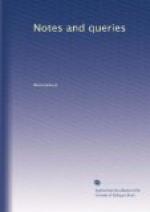Thus we are enabled to throw back more than a century these famous Hudibrastic lines, which have occasioned so many inquiries for their origin.
I take this opportunity of noticing a mistake which has frequently been made concerning the French translation of Butler’s Hudibras. Tytler, in his Essay on Translation; Nichols, in his Biographical Anecdotes of Hogarth; and Ray, in his {178} History of the Rebellion, attributes it to Colonel Francis Towneley; whereas it was the work of John Towneley, uncle to the celebrated Charles Towneley, the collector of the Marbles.
EDWARD F. RIMBAULT.
* * * * *
FIELD OF THE BROTHERS’ FOOTSTEPS.
I do not think that Mr. Cunningham, in his valuable work, has given any account of a piece of ground of which a strange story is recorded by Southey, in his Common-Place Book (Second Series, p. 21.). After quoting a letter received from a friend, recommending him to “take a view of those wonderful marks of the Lord’s hatred to duelling, called The Brothers’ Steps,” and giving him the description of the locality, Mr. Southey gives an account of his own visit to the spot (a field supposed to bear ineffaceable marks of the footsteps of two brothers, who fought a fatal duel about a love affair) in these words:—“We sought for near half an hour in vain. We could find no steps at all, within a quarter of a mile, no nor half a mile, of Montague House. We were almost out of hope, when an honest man who was at work directed us to the next ground adjoining to a pond. There we found what we sought, about three quarters of a mile north of Montague House, and about 500 yards east of Tottenham Court Road. The steps answer Mr. Walsh’s description. They are of the size of a large human foot, about three inches deep, and lie nearly from north-east to south-west. We counted only seventy-six, but we were not exact in counting. The place where one or both the brothers are supposed to have fallen, is still bare of grass. The labourer also showed us the bank where (the tradition is) the wretched woman sat to see the combat.”
Mr. Southey then goes on the speak of his full confidence in the tradition of their indestructibility, even after ploughing up, and of the conclusions to be drawn from the circumstance.
To this long note, I beg to append a query, as to the latest account of these footsteps, previous to the ground being built over, as it evidently now must be.
G.H.B.
* * * * *
ON AUTHORS AND BOOKS, NO. 4.
Verse may picture the feelings of the author, or it may only picture his fancy. To assume the former position, is not always safe; and in two memorable instances a series of sonnets has been used to construct a baseless fabric of biography.




